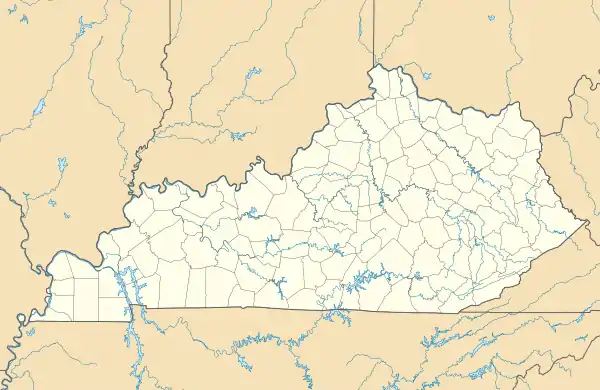Tolu, Kentucky | |
|---|---|
 Tolu | |
| Coordinates: 37°25′59″N 88°14′43″W / 37.43306°N 88.24528°W | |
| Country | United States |
| State | Kentucky |
| County | Crittenden |
| Area | |
| • Total | 0.35 sq mi (0.90 km2) |
| • Land | 0.35 sq mi (0.90 km2) |
| • Water | 0.00 sq mi (0.00 km2) |
| Elevation | 377 ft (115 m) |
| Population (2020) | |
| • Total | 81 |
| • Density | 233.43/sq mi (90.18/km2) |
| Time zone | UTC-6 (Central (CST)) |
| • Summer (DST) | UTC-5 (CDT) |
| ZIP codes | 42084 |
| Area code | 270 |
| GNIS feature ID | 515965[2] |
Tolu is an unincorporated community and census-designated place (CDP) in Crittenden County, Kentucky, United States. As of the 2010 census it had a population of 88.[3] It is located along Kentucky Route 135 near the Ohio River. It is 14 miles (23 km) northwest of Marion, the county seat.
History

Prehistoric
The earliest known settlement in what became the future town of Tolu was the Native American prehistoric archeological site of the Mississippian culture, known today as the Tolu Site was built and occupied between 1000 CE-1350 CE.[4] This sophisticated culture flourished in chiefdoms along the Ohio and Mississippi rivers, reaching its peak in size and power at Cahokia in present-day Illinois, the largest prehistoric complex north of Mexico. Peoples of the culture had wide trading networks spanning the continent along the Mississippi River, from the Great Lakes to the Gulf of Mexico.
The Tolu Site is part of the Angel phase of the Mississippian period. Because of similarities among the following sites in their styles of pottery and construction of communities, it is also considered part of the "Kincaid Set", together with Angel Mounds in Indiana and Kincaid Mounds in Illinois, and Wickliffe Mounds in far western Kentucky.
European settlement
By 1800, a small river front settlement developed that would later become Tolu, Kentucky and was for a time known as Kirksville.[5]
From the 1790s-1830s, Tolu was under the control and influence of James Ford who led a double life serving both sides of the law as a justice of the peace, planter, businessman, ferry operator, criminal gang leader, state militia officer, river pirate, slave stealer, and slave trader. The rule of Ford came to an end with his murder in 1833.[6][7]
Following a devastating windstorm in the 1830s, the town was renamed Hurricane Landing. In 1867, Hurricane Landing had an established post office. In 1884, the current town name was chosen after Tolu, a then popular hair tonic. The Hurricane Camp Meeting Grounds a Presbyterian revival camp was established in 1888-1889 and has its roots in the Hurricane Landing Church founded in 1843.[8]
Demographics
| Census | Pop. | Note | %± |
|---|---|---|---|
| 2020 | 81 | — | |
| U.S. Decennial Census[9] | |||
Arts and culture
Points of interest
- Tolu Site (prehistoric archeological site)
- Hurricane Camp Meeting Grounds[10]
- James Ford Family Cemetery Site
Notable people
- James Ford (1775-1833), was a civic leader and businessman who ran a Kentucky ferry crossing the Ohio River into Illinois, owned a five-hundred acre slave plantation in Tolu, and secret criminal leader of a gang of Ohio River pirates and highwaymen.
References
- ↑ "2020 U.S. Gazetteer Files". United States Census Bureau. Retrieved March 18, 2022.
- ↑ "US Board on Geographic Names". United States Geological Survey. October 25, 2007. Retrieved January 31, 2008.
- ↑ "Geographic Identifiers: 2010 Demographic Profile Data (G001): Tolu CDP, Kentucky". U.S. Census Bureau, American Factfinder. Archived from the original on February 12, 2020. Retrieved August 13, 2014.
- ↑ Kevin E. Smith; James V. Miller (2009). Speaking with the Ancestors-Mississippian Stone Statuary of the Tennessee-Cumberland region. University of Alabama Press. pp. 146–148. ISBN 978-0-8173-5465-7.
- ↑ Bigham, Darrel E. (1998). Towns & Villages of the Lower Ohio. University Press of Kentucky. pp. 57–58. Retrieved December 8, 2013.
- ↑ Sniveley, Jr., William Daniel (1968). "Satan's Ferryman: A True Tale of the Old Frontier". New York, NY: Franklin Prtg. and Publishing Company. p. 211.
{{cite web}}: Missing or empty|url=(help) - ↑ Rothert, Otto A. (1924). "The Outlaws of Cave-In-Rock". Carbondale, IL: Southern Illinois University Press. p. 309.
{{cite web}}: Missing or empty|url=(help) - ↑ Bigham, Darrel E. (1998). Towns & Villages of the Lower Ohio. University Press of Kentucky. pp. 57–58, 178. Retrieved December 8, 2013.
- ↑ "Census of Population and Housing". Census.gov. Retrieved June 4, 2016.
- ↑ Janine-Rice, Brother (2014). "Hurricane Camp Meeting Grounds, Crittenden County, Kentucky, February 23, 2016". gardenstogables.com.
